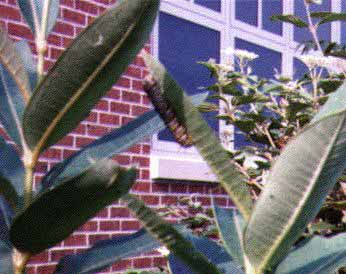
Our school underwent a major renovation from 1993 to 1994. Among
the improvements were the addition of a new library and an
Intermediate wing. I suggested turning the courtyard created by these
new wings into a habitat garden.

|
Here is a view of the library
wing just as the ground was broken for the garden in Fall
1994. Several large rocks were saved from the construction.
They were placed by the bulldozers prior to seeding the
yard. (94K)
|

|
This is a view of the
courtyard to the right of the library. Classroom windows
view the garden from two sides. (88K)
|
First, the soil was enhanced by adding horse manure from a
local farm. Next, trees and shrubs were planted by parent volunteers.
Plants, trees, and shrubs for the garden were all donated by local
nurseries and school families. Special attention was given to
planting Pennsylvania native
plants. Flowers and plants were planted by Cub Scout Bear Dens 1
& 2 Pack 146.
Four bird feeders were made by a mother. Each one is cared for by
a class that fills it as needed. A butterfly house was donated by a
parent as well. A shallow pond was dug in an area were water tends to
stand.

|
Summer
1996 the garden bloomed and gave shelter and food to
many birds and insects. Butterfly bushes were alive with
many varieties of butterflies. Birds enjoyed the seeds from
spent Coneflower and Blackeyed Susans. The shadblows and
viburnums gave berries to the birds. Beebalm, phlox, lambs
ears and lupines gave their nectar to the bees. (22K)
|

|
This past
spring, robins built a nest in the open shelter house in
full view of a delighted third grade class. They watched the
mother use the strings of jute that were hung on the trees
to build her nest. They saw her patiently sit the nest. They
rejoiced as the tiny heads could be seen reaching for the
offered food. Finally, they saw the fledglings take their
first flight. (22K)
|
We have added labels to our garden that not only identify the
plant, but also why it is there. I also developed a resource book in
the school's library which offers facts, activities and a planting
list.
Our milkweed seedlings self sowed last year.
My daughter had a welcome surprise when she came in
August to tend the garden. The Very Hungry Caterpillar had
come to call!
Learn more about life on a
milkweed plant. |

|
Bluebirds were seen checking out the bluebird house this
past fall. Perhaps we will be blessed with new residents in
the spring. |

|
Other exciting visitors:
Special things to look for in the garden.
- Rocks containing fossils of shells and sea
worms.
- Chunks of quartz found during the garden's
digging.
- Bird
friendly trees: Dogwood, Sumac, and
Serviceberry
- Berry
bushes: Viburnum, Winterberry, American
Holly, Pyracantha, High Bush Cranberry, & Choke cherry.
- Flowers: Beebalm, Milkweed, Veronica, Lupines, daylilies, sedum, Purple
Coneflower, Phlox, Asters, violets, Columbine, & Digitalis
- Interesting ferns, fungus, molds and rotting
stumps.
- Caterpillar Cafe - Parsley and dill are
planted each summer for the butterfly larve.
The essential elements to provide in a habitat
are: shelter, food, water, and a place to reproduce. We provide all
four of them.
Cool Stuff to know:
Beebalm also called Monarda was a tea
of the Native Americans. The Colonists drank it as a substitute tea
during the tea boycott.
High Bush Cranberry (Viburnum opulus) is called
Crampbark by the Native Americans. Its bark was used to relieve
cramps.
Serviceberry is called Shadblow because the Native
Americans knew when it bloomed that the shad were running in the
river.
We keep a compost heap in the far corner of the
garden. All cuttings, leaves, and grass clippings go there.
Eventually, they feed our garden and its guests.
Online enrichment: Mammals crossword
puzzle / Butterfly and moth
crossword puzzle / Butterfly
internet hunt / Birds of the meadow
puzzle / Bats
Other stuff: Tours of
garden / Fields, fencerows and
Meadows Study Unit / Wetlands / Outside-In
showcases / Bluebirds
at school / Milkweed & Monarch Butterfly Mania

The school's habitat garden has been certified as both
a Backyard Habitat
and a Schoolyard Habitat by the National Wildlife Federation.
1994-2000 Garden keeper: Cindy O'Hora

Internet
Hunts / Nature / Computers / Puzzles
& Projects / Site map / Home / Search
All trademarks, copyright and logos belong
to their respective owners.
©1997 Cynthia
O'Hora All rights reserved. Updated 7/2008
Posted 10/1997 by Cindy O'Hora
All the material in this site is
copyrighted and may not be reproduced or distributed, in whole or in
part, without the prior written permission of Cynthia O'Hora.





